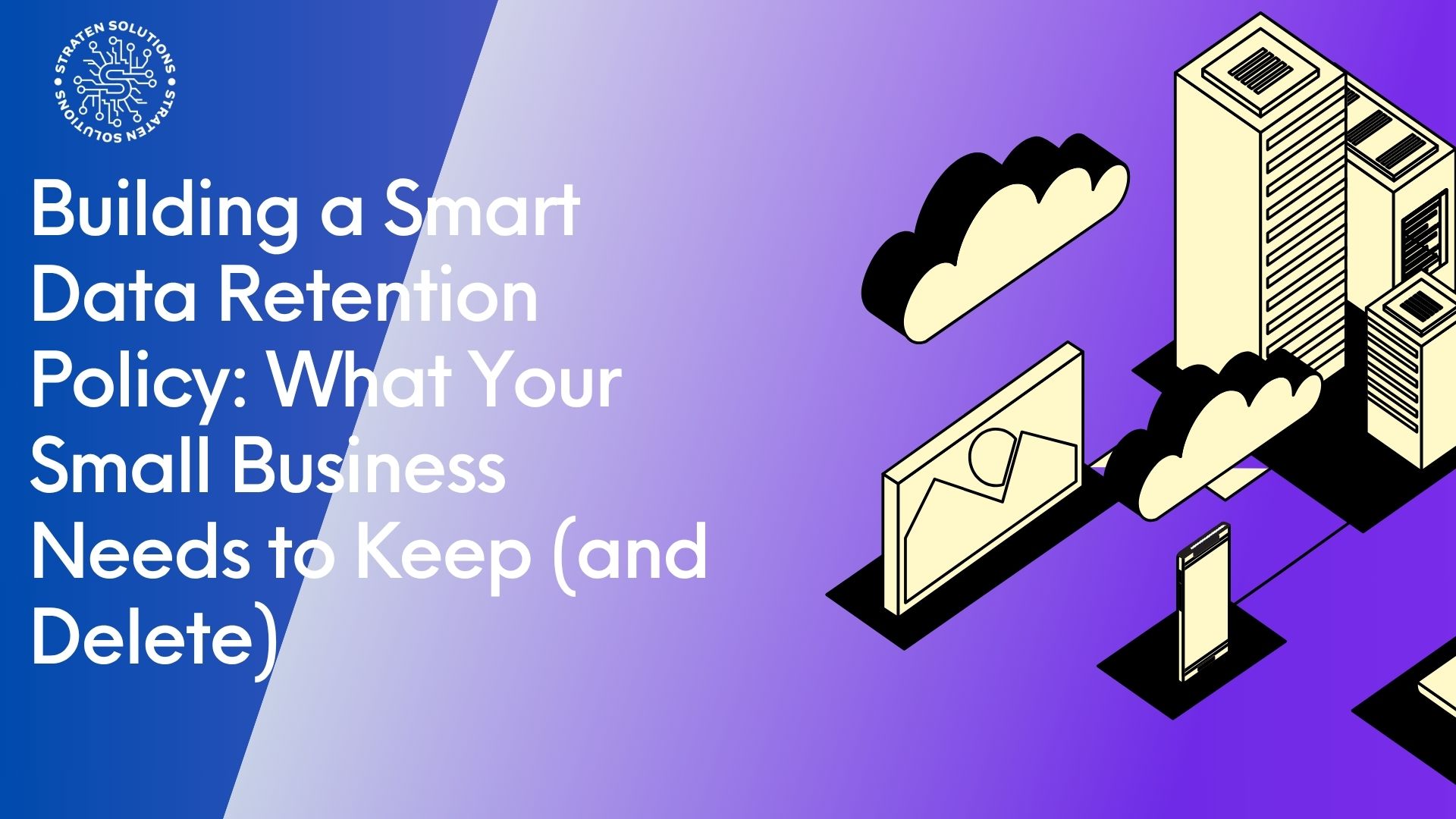
Does your small business struggle with data retention and feel overwhelmed by the sheer amount of information? You’re not alone. Data retention has become a major challenge for many businesses in today’s digital age. From employee records and contracts to financial reports, customer emails, and system backups, the volume of data can quickly become unmanageable.
According to a study by PR Newswire, 72% of business leaders admit to abandoning decisions due to data overload. Without a proper system, all this information can become chaotic. Implementing effective IT solutions and a strong data retention policy keeps your business organized, compliant, and cost-efficient. Here’s what you should keep, what to delete, and why it matters.
What Is a Data Retention Policy and Why Should You Care?
Think of a data retention policy as your company’s guidebook for managing information. It outlines how long different types of data should be kept and when it’s appropriate to dispose of them. This isn’t just about cleaning up, it’s about understanding what information is important to retain and what can be securely discarded.
Every business gathers a variety of data, some of which is critical for day-to-day operations or required by law. The rest? Often unnecessary. Holding onto everything may seem harmless, but it drives up storage costs, clutters systems, and can even pose legal risks.
A well-defined policy helps you retain the data you need safely, efficiently, and in a compliant manner.
The Goals Behind Smart Data Retention
An effective data retention policy strikes the right balance between data value and data security. The goal is to hold onto information that benefits your business, whether for analytics, audits, or customer support, but only for as long as it’s truly necessary.
Small businesses adopt data retention policies for several key reasons:
- To stay compliant with local and international regulations
- To enhance security by removing outdated or unnecessary data that could become a liability
- To boost efficiency by optimizing storage and IT resources
- To provide clear visibility into where data is stored and how it’s managed across the organization
And don’t overlook the importance of data archiving. Instead of keeping everything in your active systems, archiving allows you to store older data securely and cost-effectively in long-term storage.
Benefits of a Thoughtful Data Retention Policy
Here’s what a well-designed data retention policy can do for your business:
- Reduced storage costs: Stop wasting money on storing outdated or unnecessary files.
- Less digital clutter: Quickly locate the data that matters.
- Regulatory compliance: Stay aligned with laws like GDPR, HIPAA, and SOX.
- Smoother audits: Easily access required data when regulators request it.
- Lower legal risk: Data that no longer exists can’t be used against you in legal proceedings.
- Smarter decisions: Work with up-to-date, relevant information instead of outdated data.
Best Practices for Building Your Policy
While every business’s data retention policy will look a little different, there are universal best practices that apply across the board:
Know the legal landscape: Different industries and regions have specific data retention rules. For example, healthcare providers must comply with HIPAA and retain patient records for at least six years. Financial institutions may be required to keep certain documents for seven years or more under SOX regulations.
Align with business goals: Retention isn’t only about compliance. Your sales team might need historical data for trend analysis, or HR may need access to employee evaluations from the past few years. Make sure your policy supports both legal and operational needs.
Categorize your data: Avoid a one-size-fits-all approach. Different data types—like emails, customer records, payroll files, and marketing materials—have different functions and should have customized retention timelines.
Archive doesn’t hoard: Move data that’s needed for the long term into dedicated archival storage. This keeps your main systems lean and efficient without losing valuable historical information.
Prepare for legal holds: If your business is involved in litigation, you’ll need to halt the deletion of any potentially relevant data. Your policy should include clear procedures for this.
Create two versions of your policy: One comprehensive version for legal and compliance teams, and a simplified, easy-to-understand version for everyday use by employees and department heads.
Creating the Policy Step-by-Step
Ready to get started? Here’s how to go from idea to implementation:
- Assemble a team: Bring together IT, legal, HR, and department heads. Everyone has unique needs and insights.
- Identify all applicable compliance requirements: This includes documenting local laws, national regulations, and any industry-specific guidelines that impact how long data must be kept and when it should be disposed of.
- Map out your data environment: Understand the different types of data your organization collects, where it’s stored, who is responsible for it, and how it flows between systems.
- Establish clear retention periods for each data category: Decide when data should remain in active storage, when it should be archived, and when it should be securely deleted.
- Clearly define roles and responsibilities: Designate individuals or teams to manage, monitor, and enforce the policy across the organization.
- Incorporate automation wherever possible: Use technology to streamline tasks like data archiving, secure deletion, and metadata tagging to reduce manual workload and minimize human error.
- Keep your policy current by conducting regular reviews: Evaluate it annually or bi-annually to ensure it aligns with evolving legal requirements and business needs.
- Provide proper training: Make sure employees understand the policy, how it applies to their roles, and the best practices for handling and managing data responsibly.
A Closer Look at Compliance

If your business operates in a regulated industry or simply handles customer data, compliance isn’t optional. There are strict data retention laws worldwide that businesses must adhere to. A few key examples include:
HIPAA: Healthcare organizations must keep patient records for a minimum of six years.
SOX: Public companies are required to retain financial documents for seven years.
PCI DSS: Companies that handle credit card transactions must securely store and dispose of sensitive payment data.
GDPR: Any organization handling data from EU citizens must specify what personal data is collected, the purpose, and how long it will be retained.
CCPA: U.S. businesses operating in or serving California must offer transparency and opt-out options regarding personal data use.
Failing to comply with these regulations can result in heavy fines and serious damage to your brand’s reputation. Partnering with a knowledgeable IT service provider can help ensure your business stays compliant and protected.
Clean Up Your Digital Closet
Just as you wouldn’t keep every receipt, email, or sticky note forever, your business shouldn’t hold onto data without a clear purpose. A smart, well-structured data retention policy is more than just an IT requirement; it’s a strategic step to protect your business, reduce costs, and ensure compliance with regulations.
IT solutions go beyond fixing technical issues; they’re designed to help you work more efficiently. When it comes to managing data, staying organized can make a big difference. Don’t wait until your systems slow down or a compliance audit catches you off guard.
Contact us today to start creating a data retention policy that puts you in control of your business’s digital footprint.






